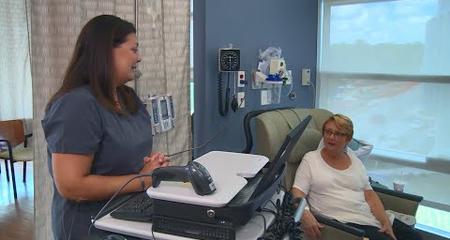Radiation therapy is a key component of care for many patients with pancreatic cancer. Radiation oncologists at Froedtert & the Medical College of Wisconsin are at the forefront of innovative efforts to combine radiation with surgery and drug therapy.
Chemoradiation Before Surgery
For the last several decades, the standard care plan for operable pancreatic tumors has been surgery followed by radiation therapy and chemotherapy. Based on current research, the care team at the Clinical Cancer Center strongly advocates a “surgery last” approach. Most patients with resectable or “borderline resectable” pancreatic tumors receive combined chemotherapy and radiation therapy (chemoradiation) prior to undergoing surgery to remove the tumor.
The main drawback of the traditional care plan is that the order of care makes it difficult for patients to complete the full course of therapy. Patients must recover from surgery before they can undergo drug and radiation therapy, and adequate healing can take some time. In the interval, many cancers show evidence of metastatic spread. Approximately 40 percent of patients undergoing traditional treatment never complete the full course of therapy.
There are several benefits to preoperative chemoradiation:
- Giving patients chemotherapy and radiation before surgery increases the number of patients who receive complete treatment.
- Treating cancers ahead of time with chemoradiation can shrink the tumor, increasing the likelihood of a complete tumor resection with no lymph node involvement. This can be especially important for patients with a borderline resectable tumor.
- Preoperative therapy exposes any microscopic cancer cells (including cells that have spread beyond the pancreas) to the cancer drug earlier.
- Preoperative chemotherapy takes advantage of the tumor’s blood supply — drugs can reach cancer cells directly through the arteries that feed the tumor.
- This approach can also help the care team identify patients who will not benefit from surgery. If metastases appear during or shortly after preoperative chemoradiation, the patient likely already had uncontrollable microscopic spread of the disease. With the standard surgery-first approach, the patient would have undergone a major operation with no benefit.
Chemoradiation Process
The typical course of chemoradiation includes five and a half to six weeks of radiation therapy delivered concurrently with low-dose chemotherapy, which acts as a radiation sensitizer. Some patients with borderline resectable tumors receive a course of chemotherapy alone, followed by the chemoradiation treatment.
Radiation is delivered using technologies that are able to tightly shape the dose to the tumor target. In most cases, the care team uses intensity modulated radiation therapy (IMRT), which maximizes radiation delivered to the tumor while sparing nearby organs such as the kidneys, the small bowel and the liver.
Because the radiation fields are so precise, the care team studies each patient’s breathing motion before therapy using four-dimensional CT scanning. If a study shows that a patient’s organs move significantly during breathing, techniques are used to target radiation only during a certain point in the breathing cycle, when the tumor is in the “target zone.”
Surgery typically takes place four to six weeks after chemoradiation, if scans show no evidence of metastatic spread. Certain patients receive more chemotherapy following surgery, depending on whether or not complete tumor removal was achieved.
Radiation Therapy for Inoperable Pancreatic Cancer
Patients with an inoperable pancreatic tumor may receive radiation therapy, depending on the extent of the disease and the tumor’s response to chemotherapy. Radiation is not used to treat pancreatic cancers that have spread to other organs, except when used palliatively to alleviate symptoms of metastatic disease.
More to Explore





